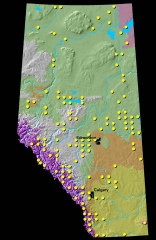Common Bearberry
Arctostaphylos uva-ursi – The fruit of the bearberry is a favourite food of bears.
Other names
- In Latin: Arctostaphylos uva-ursi (L.) Spreng
Uva-ursi uva-ursi (L.) Britto - In English: kinnikinnick, mealberry, sandberry (many others, including: mountain-box, universe-vine, rapper-dandies, fox-plum, hog-crawberry, barren myrtle)
- In French: bousserole, raisin d’ours, sac-a-commis
- In Chipewyan: délhni (“crane food” = berries)
- In Cree: muskominanatik (=berry), kinnikinnick (=leaves)
- In Slave: netene
The scientific name for the genus is based on the Greek “Arktos”, bear, and “staphyle”, a bunch of grapes. The species name repeats this, in Latin (uva – berry; ursi – bear).
Kinnikinnick, one of the common names in frequent use, is a First Nation Peoples’ word for “smoking mixture”. The French “sac-a-commis” is an old name that refers to the habit of early Hudson’s Bay company clerks habitually carrying around a pouch full of dried leaves.
Taxonomy
ERICACEAE (Heath family)
Description
- Form: This trailing dwarf shrub has long flexible sprawling branches. It forms a green mat sometimes several metres wide over its preferred dry sandy habitat. The leafy stems are covered with soft, white hairs. With its evergreen leaves and bright red berries, it brightens up winter woodlands and meadows.
- Leaves: The glossy dark-green evergreen leaves are about 1 – 2 cm long. In texture they are leathery, with smooth edges. The leaves are spatula-shaped, widest toward the tip.
- Flowers: Small (4-6 mm), white to pinkish, urn-shaped flowers appear in small hanging clusters at the branch tips. Around the opening of the flower is a ring of bright pink. They can be found from about May to June.
- Fruit: The dull, orange-red berry is dry and mealy, with a stone consisting of several nutlets. This type of fruit is called a drupe; it looks like a miniature apple.
Distribution
This circumboreal shrub is found in sandy, well-drained sites in woodlands and open areas.
Habitat
Bearberry is shade-intolerant, and is an indicator for forest managers of nutrient-poor, dry to very dry soils. Preferred habitat is dry forests and exposed, sandy areas such as sandhills, or often rocky sites. It is also found in somewhat moister sites, and in disturbed areas such as roadsides.
How to Observe
- Mark a plot of bearberry, about one metre by one metre in size.
- Record these dates:
- First bloom: In at least three places in the plot of plants under observation, the first flowers have opened completely (when the first flowers open like little pink “lips” at the tip (in 3 different places).
- Mid bloom: Approximately half (50%) of the flowers on the plants under observation are open at the tip.
Life Cycle
The flowers bloom from May to June; the fruit matures by mid-August and remains on the plant throughout the winter. It also reproduces vegetatively from rooting stems (called stolons), sometimes forming mats several metres wide.
Phenology
It blooms relatively early; flowers appear from May to June.
Ecology
Several varieties are distinguished based on the covering of hairs on the stem. These characteristics are a response to environmental, as well as genetic factors, so the varieties are often not officially recognised.
Not only bears, but also grouse find the dry, mealy berries irresistible.
Common bearberry is the alternate host of one of the most conspicuous diseases of spruce in the prairie provinces, called yellow witches’ broom. Look for evidence of the disease organism, the orange-coloured spore-producing organs produced on purple-brown spots on the underside of the leaves.
Human Uses
Kinnikinnick means “mixture” in Algonkian languages and is used to refer to any of several plants mixed with tobacco as extenders. Dry, ground leaves of bearberry were mixed with the reddish bark of red-osier dogwood and smoked as a tobacco substitute by First Nations People. The leaves were mixed with commercial tobacco once tobacco became available. Although the berries are too dry to eat alone, several northwest First Nations tribes mixed them with fat or boiled them in soups.
Because the berries remain on the branches all year and are rich in carbohydrates, they are an important survival food.
Bearberry has some medicinal properties, for example, as a diuretic. A tea made from the roots can be drunk to treat a persistent cough. This plant is rich in tannin and arbutin and should be used with caution. The leaves have been used to tan hides.
Horticulture (Use in the Garden)
An attractive and hardy ornamental shrub, bearberry is useful as a ground-cover in dry areas of the garden.
References
Britton, N.L. and H.A. Brown. 1970. An illustrated flora of the northern United States and Canada. 2nd Ed. Vol. 2. Dover Public. Inc. New York.
Douglas, G. 1998. Illustrated flora of British Columbia. Vols. 1-5. British Columbia, Ministry of Environment, Lands and Parks. Victoria, B.C.
Hitchcock, C.L. and A. Cronquist. 1973. Flora of the Pacific Northwest. Univ. of Washington Press, Seattle.
Hultén, E. 1968. Flora of Alaska and neighboring territories. Stanford University Press, Stanford, California.
Kershaw, L. 2000. Edible and medicinal plants of the Rockies. Lone Pine Publishing. Edmonton.
MacKinnon, A., J. Pojar and R. Coupe. 1992. Plants of northern British Columbia. B.C. Ministry of Forests and Lone Pine Publishing.
Marles, Robin J. et al. 2000. Aboriginal plant use in Canada’s Northwest Boreal Forest. Natural Resources Canada. UBC Press. Vancouver.
Moss, E.H. 1983. Flora of Alberta. 2nd Edition edited by J. Packer. Univ. of Toronto Press. Toronto.
Ringius, Gordon S. and Richard A. Sims. 1997. Indicator plant species in Canadian forests. Canadian Forest Service, Natural Resources Canada. Ottawa.
Scoggan, H.J. 1978-79. The flora of Canada. Vols. 1-4. National Museums of Canada. Ottawa.
Turner, N.J. 1987. Food plants of British Columbia Indians – coastal peoples. British Columbia Provincial Museum. Victoria.





